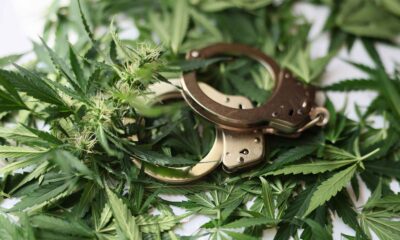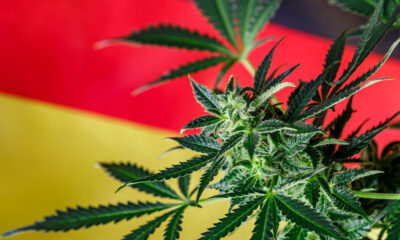
Legal
Study: Having Cannabis ‘In Your System’ Doesn’t Mean It’s Unsafe to Drive
Canadian researchers argue there shouldn’t be a breathalyzer or blood test for weed. Instead, there should be a “behavioral” test to see if a driver is impaired.
A new study in Canada on cannabis and driving is challenging the idea that people are not safe to drive cars unless they have zero THC in their system. The study’s authors say that THC can indeed impair driving — but that applying laws designed for booze to marijuana is bad science and bad policy.
With cannabis legal in Canada, authorities have been grappling with how to deal with the question of THC and road safety. Canada currently requires that drivers have no more than two nanograms of THC per milliliter of blood (a very small amount), but some states go further and allow no THC at all, a compound that can linger in blood for days after consumption.
However, the study, undertaken by Canadian researchers and released in December, finds that subjects using a “driving simulator” showed no signs of impairment a day after they smoked cannabis — even though they still tested positive for THC.
One of the study’s leaders, retired University of Victoria professor Scott Macdonald, told Canada’s Global News that the findings indicate a zero-tolerance standard for THC in the bloodstream of motorists is “not scientific.”
“I consider it one of the biggest myths about cannabis, that there are 24-hour hangover effects that are measurable,” Macdonald said. “When people smoke cannabis, they’re only impaired for a short, short period of time. You could have THC in your bloodstream, but you’re not a danger.”
High Drivers Are Impaired, But Not For Days
Here’s how the study worked. Researchers at the Toronto-based Centre for Addiction and Mental Health (CAMH) gave participants 10 minutes to smoke cannabis to a level of their own choosing and then tested them in the simulator. The simulator has all the trappings of an actual car: seatbelt, ignition, steering wheel, and gas and brake pedals. But it takes place indoors in a laboratory, not on the road. The windshield is actually a computer screen displaying a virtual-reality road, complete with oncoming traffic in the other lane, the occasional stalled vehicle on the shoulder and other potential crash opportunities.
Because participants could control their own consumption, THC blood levels in the group varied, ranging from zero to 42 nanograms per milliliter. Some were also given THC-free cannabis as a placebo.
Immediately after smoking, the THC group indeed showed signs of impairment, centering the virtual car poorly in its lane and driving at an inappropriately slow speed. However, in follow-up tests 24 and 48 hours later, they performed normally in the simulator — despite still having detectable THC levels in their blood.
“We found significant evidence of difference in driver behavior, heart rate and self-reported drug effects 30 minutes after smoking cannabis, but… we found little evidence to support residual effects,” the authors wrote.
While alcohol dissipates from the bloodstream rapidly after intoxication, THC can keep showing up on tests long after any impairment has ended. Macdonald told Global News: “You can’t just use the laws that we have for alcohol and apply them to cannabis, especially now that cannabis is legal.”
“The biological tests are not useful for identifying people that represent a safety risk,” he added. “What we’re left with is behavioral symptoms. We’re still working on developing tests to assess whether an individual who consumes cannabis is a safety risk. It’s hard to do.”
Some states in America have adopted that model, where police officer discretion is allowed to determine if someone is high rather than blood testing.
In Colorado, for example, the legal blood limit for THC is five nanograms per milliliter of blood. However, the state’s Department of Transportation notes, “No matter the level of THC, law enforcement officers base arrests on observed impairment.” In California, it is illegal to drive under the influence of any drug, but there is no blood THC limit.
Law Out of Wack with Science
Several Canadian provinces currently take a zero-tolerance approach to THC in the blood of young or new drivers. In Ontario, new drivers violating the THC zero-tolerance rule face a three-day license suspension, plus a $250 fine on top of a $281 license reinstatement fee. And that’s just for the first offense. Penalties go up for a second and third.
In Saskatchewan, the law is even harsher. In that province, new drivers with any level THC face a 60-day license suspension, a three-day vehicle seizure and four demerit points.
The Ontario Transportation Ministry defends its policy. “In October 2018, the Canadian Society of Forensic Science released a report stating that impairment from cannabis begins almost immediately and can last up to six hours or more, depending on factors such as THC levels and how it is consumed,” a ministry spokesperson said in an e-mailed response to Global News. “Since the effects of cannabis vary, there is no way to know exactly how long to wait before it is safe for you to drive.”
This study, online at the Canadian Society of Forensic Science, is obviously contradicted by the new findings of the CAMH.
In America, states set the rules about driving high. In Canada, provinces have their own rules, but there is a federal umbrella of laws. Under Canada’s Cannabis Act, two to five nanograms of THC per milliliter is a “summary conviction offense” — Canada’s equivalent of a misdemeanor. Higher levels are a “hybrid offense” — a special category under Canadian law between the U.S. equivalents of a misdemeanor and a felony.
Advocates are arguing now, that in the face of studies that show THC is not impairing after 24 hours, the laws in Canada should change.
The Tough Questions
The point about alcohol standards not working with THC in such matters has been made before. It is why the top court in Massachusetts struck down roadside sobriety tests for cannabis in 2017.
But beyond the discrepancy in how long the offending substance remains in the bloodstream, alcohol also impairs far more than cannabis does. As Macdonald admitted to Global News: “Cannabis is not in the same class as alcohol in terms of safety risk. Alcohol is much, much worse.”
A study released by Kansas State University earlier this year found that cannabis legalization is not linked to an increase in traffic deaths in the United States. This may come as little surprise to those with experience in cannabis’ actual effects, but challenges an entrenched assumption of prohibitionist propaganda (which is obviously today much stronger in the U.S. than in Canada).
The entire question of “marijuana-impaired driving” tends to be misunderstood. For example, it is true that Colorado has seen an increase in overall road fatalities since legalization in 2012, as well as an increase in cannabis-related driving offenses. But the increase in road fatalities is consistent with the trend across the U.S. — and likely related to more motorists on the highways due to low oil prices. It was fortuitous for the prohibitionists that the world oil slump began in 2014, just in time to provide a negative spin for cannabis legalization.
While there is no excuse for impaired drivers getting on the road (obviously), the long-term answers to reducing traffic fatalities lie in a far-reaching reconfiguration of urban design and transportation infrastructure, in the U.S. and Canada alike. The Green New Deal now being proposed by progressive Congress members in the U.S. at least begins to open this conversation.
TELL US, do you think there should be a cannabis breathalyzer test?


























